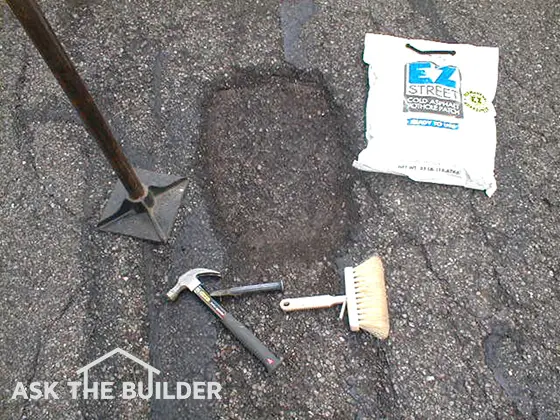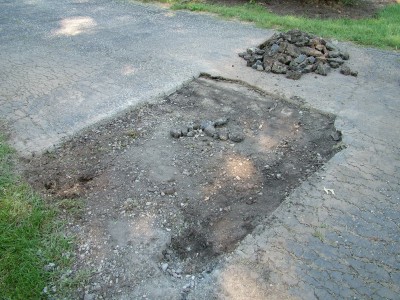Asphalt (Blacktop) Patching Material

©2017 Tim Carter
Black Rubber
Several years ago, the highway maintenance crew in my village worked on my street. The first thing they did was to use compressed air to blow out debris from the cracks in the roadway and along the curb. Several hours later, a large dump truck arrived with a strange trailer. The trailer contained a tank filled with a high performance crack filler. This tank was heated by a propane burner. The material in the tank was an asphalt solution that contained some new synthetic rubbers. The maintenance person who walked with the trailer had a wand that was suspended from a boom. As he squeezed a trigger, hot material would flow from the wand tip. A second person had a V shaped squeegee that pushed the material down into the crack and it also spread it onto each side of the crack.
The material has done a fine job of filling the cracks. You can get very similar materials that do not require heating. The best crack fillers have lots of rubber in the mixture and typically cost twice as much per gallon as the inferior or low- tech crack fillers.
The crack fillers pour right from a bottle or jug. I have determined that the trick to getting them to stick is to make sure that the cracks are clean, dust free, and dry. If you have the patience to make this happen, you can get long term crack repairs.
Do you need to patch your asphalt? Save time and money by using my Asphalt/Blacktop/Tar & Chip Installation & Repair Checklist. I offer a 100% Money Back Guarantee.
Patching Potholes
I have seen many a friend and relative fail miserably at trying to patch low spots or depressions in their blacktop driveways. In the past they could blame their failure on the material they were using. They can't do that any longer.
You can now purchase pothole patching compounds that are in a bag and will produce permanent repairs if you follow several easy steps. It is important to buy the right materials. I list several high performance products later in this bulletin. Do your best to find one of these great products if you want to only patch your potholes once.

Oh yes, the other reason that pothole repairs fail is because the material was not installed right. I'll bet you have seen holes or low spots develop in your driveway where the actual asphalt simply sinks. You can't see down to the gravel base as the asphalt stretched over the hollow spot.
To repair holes like this by simply dumping in some cold patch is asking for trouble. As the cold patch material nears the edge of the depression, it thins out to nothing. To repair a depression like this you must crack the surface of the asphalt and create vertical edges in the existing blacktop that are at least 1.5 inches high. You can see that when the patching material is installed this way, its minimum thickness at any point would be 1.5 inches, not the thickness of a solitary asphalt coated stone from the patching mix!
In a Rush
Are you an impatient weekend warrior who has decided to fix the driveway holes, cracks, and seal it in one weekend? Well, forget about it! If you have to do all of these things to a driveway, it is going to take a minimum of four weekends. You should patch the holes on the first weekend. As soon as you expose the patching material to the air, you begin the 30 day countdown that is required to allow the material to fully cure and get hard. If you cover the patch with driveway sealer, you block air from getting to the patch. The patch will then be spongy for a long period of time. Spend the second weekend cleaning cracks and getting them to dry. Apply the crack filler and let it set for one week. Check to see if you need to fill deep cracks twice. After 30 days, apply your sealer!
Companion Articles: Tips on Patching Blacktop and Asphalt, High Performance Asphalt Repair Products, Asphalt Patching
Column B283